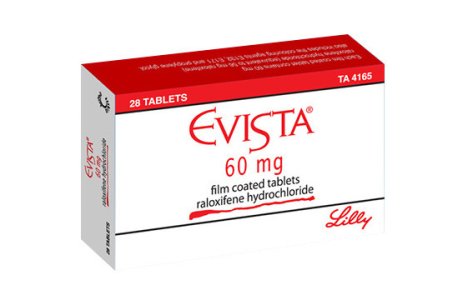Evista (raloxifene hydrochloride) is a second-generation Selective Estrogen Receptor Modulator (SERM). It is approved by the FDA for this use in women. Although it bears structural and mechanistic similarities to other SERMs which have been approved either as fertility drugs (Clomid) or Breast Cancer medication (Nolvadex), it has not been approved for either of those uses.
Background
Raloxifene was originally patented in 1983, and released thereafter by the pharmaceutical house Eli Lilly under the brand name Evista.
Action
Ralixofene exerts its effects by antagonizing the estrogen receptor in some tissues, and agonizing it in others. In this way, certain estrogenic pathways are activated and others are blockaded. It seems to exert estrogenic effects on blood lipids, reducing LDL and total cholesterol, as well as estrogenic effects on bone, improving density. It would also appear to exert anti-estrogenic effects in breast tissue, displacing the traditional effects of estrogen, effectively helping prevent breast cancer in postmenopausal women.
The three-dimensional protein folding around estradiol to activate the receptor complex. Helix 12 must fold across the steroid and seal the ligand-binding pocket. The critical amino acids 538, 542, and 545 in the AF-2 region are exposed to allow binding to coactivators before a transcription complex can be constructed. By contrast, when raloxifene occupies the binding pocket, Helix 12 is reposited and the critical amino acids in the AF-2 region are now masked. Reproduced from Brzozowski et al. (1997)
Technical Data
Although Raloxifene was only approved for the treatment of osteoperosis in women, it has potential indications in the use of breast cancer prevention and secondary treatment. However, as with most SERMs, it’s possible use has also been explored in men for a variety of conditions.
Unlike Nolvadex which causes a very significant raise in testosterone levels, Raloxifene only causes a 20% increase (1). Thus, for Post Cycle purposes, it probably can not be relied on. For preventing Gynecomasia, it may be as good as other SERMs.

User Notes
Raloxifene is a relatively new drug to the performance enhancement scene. As a result very few people have actually experimented with it. The few bodybuilders who have actually used it typically compare it to the more commonplace SERM known as Tamoxifen (Nolvadex). Since it’s relatively new, it’s not widely available to most people and therefore has not yet gotten the widespread acceptance that other similar medications have gotten. However, with respect to this drugs potential, it could be potentially as useful as either Nolvadex or Clomid as an estrogen agonist/antagonist. As a testosterone booster, I have my doubts.
Raloxifene is the chemical name of active ingredient in Evista. Evista is a registered trademark of Eli Lilly and Company in the United States and/or other countries.
References
Background
Raloxifene was originally patented in 1983, and released thereafter by the pharmaceutical house Eli Lilly under the brand name Evista.
Action
Ralixofene exerts its effects by antagonizing the estrogen receptor in some tissues, and agonizing it in others. In this way, certain estrogenic pathways are activated and others are blockaded. It seems to exert estrogenic effects on blood lipids, reducing LDL and total cholesterol, as well as estrogenic effects on bone, improving density. It would also appear to exert anti-estrogenic effects in breast tissue, displacing the traditional effects of estrogen, effectively helping prevent breast cancer in postmenopausal women.
The three-dimensional protein folding around estradiol to activate the receptor complex. Helix 12 must fold across the steroid and seal the ligand-binding pocket. The critical amino acids 538, 542, and 545 in the AF-2 region are exposed to allow binding to coactivators before a transcription complex can be constructed. By contrast, when raloxifene occupies the binding pocket, Helix 12 is reposited and the critical amino acids in the AF-2 region are now masked. Reproduced from Brzozowski et al. (1997)
Technical Data
Although Raloxifene was only approved for the treatment of osteoperosis in women, it has potential indications in the use of breast cancer prevention and secondary treatment. However, as with most SERMs, it’s possible use has also been explored in men for a variety of conditions.
Unlike Nolvadex which causes a very significant raise in testosterone levels, Raloxifene only causes a 20% increase (1). Thus, for Post Cycle purposes, it probably can not be relied on. For preventing Gynecomasia, it may be as good as other SERMs.

User Notes
Raloxifene is a relatively new drug to the performance enhancement scene. As a result very few people have actually experimented with it. The few bodybuilders who have actually used it typically compare it to the more commonplace SERM known as Tamoxifen (Nolvadex). Since it’s relatively new, it’s not widely available to most people and therefore has not yet gotten the widespread acceptance that other similar medications have gotten. However, with respect to this drugs potential, it could be potentially as useful as either Nolvadex or Clomid as an estrogen agonist/antagonist. As a testosterone booster, I have my doubts.
Raloxifene is the chemical name of active ingredient in Evista. Evista is a registered trademark of Eli Lilly and Company in the United States and/or other countries.
References
- Comparison of effects of the rise in serum testosterone by raloxifene and oral testosterone on serum insulin-like growth factor-1 and insulin-like growth factor binding protein-3. Maturitas. 2005 Jul 16;51(3):286-93.
